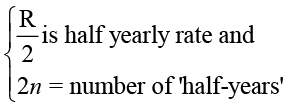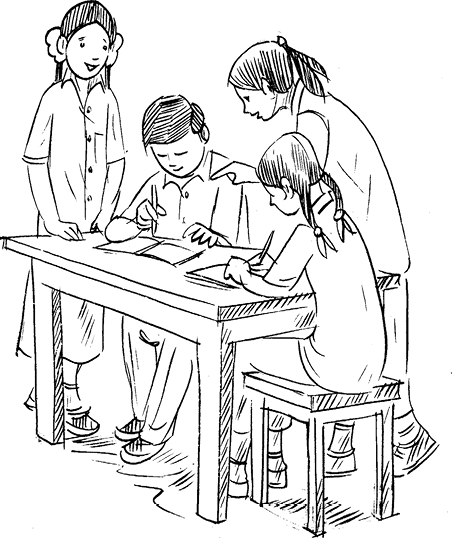Table of Contents
8.1 Recalling Ratios and Percentages
A basket has two types of fruits, say, 20 apples and 5 oranges.
Then, the ratio of the number of oranges to the number of apples = 5 : 20.

The comparison can be done by using fractions as,  =
= 
The number of oranges is  th the number of apples. In terms of ratio, this is
th the number of apples. In terms of ratio, this is
1 : 4, read as, “1 is to 4”
Number of apples to number of oranges =  which means, the number of apples is 4 times the number of oranges. This comparison can also be done using percentages.
which means, the number of apples is 4 times the number of oranges. This comparison can also be done using percentages.
There are 5 oranges out of 25 fruits.
So percentage of oranges is

[Denominator made 100].
OR
By unitary method:
Out of 25 fruits, number of oranges are 5.
So out of 100 fruits, number of oranges
=  = 20.
= 20.
Since  contains only apples and oranges,
contains only apples and oranges,
So, percentage of apples + percentage of oranges = 100
or percentage of apples + 20 = 100
or percentage of apples = 100 – 20 = 80
Thus the basket has 20% oranges and 80% apples.
Example 1: A picnic is being planned in a school for Class VII. Girls are 60% of the total number of students and are 18 in number.
The picnic site is 55 km from the school and the transport company is charging at the rate of ₹ 12 per km. The total cost of refreshments will be ₹ 4280.
Can you tell.
1. The ratio of the number of girls to the number of boys in the class?
2. The cost per head if two teachers are also going with the class?
3. If their first stop is at a place 22 km from the school, what per cent of the total distance of 55 km is this? What per cent of the distance is left to be covered?
Solution:
1. To find the ratio of girls to boys.
Ashima and John came up with the following answers.
They needed to know the number of boys and also the total number of students.
Ashima did this
Let the total number of students
be x. 60% of x is girls.
Therefore, 60% of x = 18
 = 18
= 18
or, x =  = 30 = 30
= 30 = 30
Number of students = 30.
OR
John used the unitary method
There are 60 girls out of 100 students.
There is one girl out of students.
So, 18 girls are out of how many students?
Number of students =  =30
=30
So, the number of boys = 30 – 18 = 12.
Hence, ratio of the number of girls to the number of boys is 18 : 12 or  =
=  .
.
 is written as 3 : 2 and read as 3 is to 2.
is written as 3 : 2 and read as 3 is to 2.
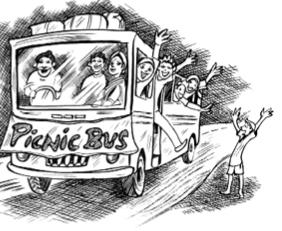
2. To find the cost per person.
Transportation charge = Distance both ways × Rate
= ₹ (55 × 2) × 12
= ₹ 110 × 12 = ₹ 1320
Total expenses = Refreshment charge
+ Transportation charge
= ₹ 4280 + ₹ 1320
= ₹ 5600
Total number of persons = 18 girls + 12 boys + 2 teachers
= 32 persons
Ashima and John then used unitary method to find the cost per head.
For 32 persons, amount spent would be ₹ 5600.
The amount spent for 1 person = ₹  = ₹ 175.
= ₹ 175.
3. The distance of the place where first stop was made = 22 km.
To find the percentage of distance:
Ashima used this method:


OR
John used the unitary method:
Out of 55 km, 22 km are travelled.
Out of 1 km,  km are travelled.
km are travelled.
Out of 100 km,  × 100 km are travelled.
× 100 km are travelled.
That is 40% of the total distance is travelled.
Both came out with the same answer that the distance from their school of the place where they stopped at was 40% of the total distance they had to travel.
Therefore, the percent distance left to be travelled = 100% – 40% = 60%.
TRY THESE
In a primary school, the parents were asked about the number of hours they spend per day in helping their children to do homework. There were 90 parents who helped for  hour to
hour to  hours. The distribution of parents according to the time for which, they said they helped is given in the adjoining figure ; 20% helped for more than
hours. The distribution of parents according to the time for which, they said they helped is given in the adjoining figure ; 20% helped for more than  hours per day;
hours per day;
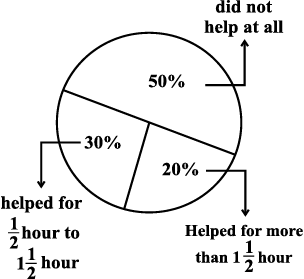
 hour to
hour to  hours; 50% did not help at all.
hours; 50% did not help at all.Using this, answer the following:
(i) How many parents were surveyed?
(ii) How many said that they did not help?
(iii) How many said that they helped for more than  hours?
hours?

Exercise 8.1
1. Find the ratio of the following.
(a) Speed of a cycle 15 km per hour to the speed of scooter 30 km per hour.
(b) 5 m to 10 km (c) 50 paise to ₹ 5
2. Convert the following ratios to percentages.
(a) 3 : 4 (b) 2 : 3
3. 72% of 25 students are interested in mathematics. How many are not interested
in mathematics?
4. A football team won 10 matches out of the total number of matches they played. If their win percentage was 40, then how many matches did they play in all?
5. If Chameli had ₹ 600 left after spending 75% of her money, how much did she have in the beginning?
6. If 60% people in a city like cricket, 30% like football and the remaining like other games, then what per cent of the people like other games? If the total number of people is 50 lakh, find the exact number who like each type of game.
8.2 Finding the Increase or Decrease Per cent
We often come across such information in our daily life as.
(i) 25% off on marked prices (ii) 10% hike in the price of petrol
Let us consider a few such examples.
Example 2: The price of a scooter was ` 34,000 last year. It has increased by 20% this year. What is the price now?
Solution:
Amita said that she would first find the increase in the price, which is 20% of ₹ 34,000, and then find the new price.
20% of ₹ 34000 = ₹ 
= ₹ 6800
New price = Old price + Increase
= ₹ 34,000 + ₹ 6,800
= ₹ 40,800
OR
Sunita used the unitary method.
20% increase means, ` 100 increased to ` 120.
So, ` 34,000 will increase to?
Increased price = `
= ` 40,800
Similarly, a percentage decrease in price would imply finding the actual decrease followed by its subtraction the from original price.
Suppose in order to increase its sale, the price of scooter was decreased by 5%. Then let us find the price of scooter.
Price of scooter = ₹ 34000
Reduction = 5% of ₹ 34000
= ₹  = ₹ 1700
= ₹ 1700
New price = Old price – Reduction
= ₹ 34000 – ₹ 1700 = ₹ 32300
We will also use this in the next section of the chapter.
8.3 Finding Discounts

Discount is a reduction given on the Marked Price (MP) of the article.
This is generally given to attract customers to buy goods or to promote sales of the goods. You can find the discount by subtracting its sale price from its marked price.
So, Discount = Marked price – Sale price
Example 3: An item marked at ` 840 is sold for ` 714. What is the discount and discount %?
Solution: Discount = Marked Price – Sale Price
= ₹ 840 – ₹ 714
= ₹ 126

Since discount is on marked price, we will have to use marked price as the base.
On marked price of ₹ 840, the discount is ₹ 126.
On MP of ₹ 100, how much will the discount be?
Discount =  = 15%
= 15%
You can also find discount when discount % is given.
Example 4: The list price of a frock is ₹ 220. A discount of 20% is announced on sales. What is the amount of discount on it and its sale price.
Solution: Marked price is same as the list price.

20% discount means that on ₹ 100 (MP), the discount is ₹ 20.
By unitary method, on ₹1 the discount will be ₹  .
.
On ₹ 220, discount = ₹  = ₹ 44
= ₹ 44
The sale price = (₹ 220 – ₹ 44) or ₹ 176
Rehana found the sale price like this —
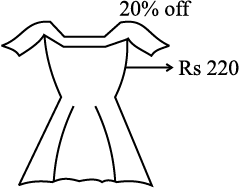
A discount of 20% means for a MP of ₹ 100, discount is ₹ 20. Hence the sale price is ₹ 80. Using unitary method, when MP is ₹ 100, sale price is ₹ 80;
When MP is ₹ 1, sale price is ₹  .
.
Hence when MP is ₹ 220, sale price = ₹  = ₹ 176.
= ₹ 176.

Even though the discount was not found, I could find the sale price directly.
TRY THESE
8.3.1 Estimation in percentages
Your bill in a shop is ₹ 577.80 and the shopkeeper gives a discount of 15%. How would you estimate the amount to be paid?
(i) Round off the bill to the nearest tens of ₹ 577.80, i.e., to ₹ 580.
(ii) Find 10% of this, i.e., ₹  .
.
(iii) Take half of this, i.e.,  .
.
(iv) Add the amounts in (ii) and (iii) to get ₹ 87.
You could therefore reduce your bill amount by ₹ 87 or by about ₹ 85, which will be ₹ 495 approximately.
1. Try estimating 20% of the same bill amount. 2. Try finding 15% of ₹ 375.
8.4 Prices Related to Buying and Selling (Profit and Loss)

For the school fair (mela) I am going to put a stall of lucky dips. I will charge ₹ 10 for one lucky dip but I will buy items which are worth Rs5.

So you are making a profit of 100%.
No, I will spend Rs 3 on paper to wrap the gift and tape. So my expenditure is Rs 8.
This gives me a profit of ` 2, which is, only.
These expenses are sometimes referred to as overhead charges. These may include expenses like amount spent on repairs, labour charges, transportation etc.
8.4.1 Finding cost price/selling price, profit %/loss%
Example 5: Sohan bought a second hand refrigerator for ₹ 2,500, then spent ₹ 500 on its repairs and sold it for ₹ 3,300. Find his loss or gain per cent.
Solution: Cost Price (CP) = ₹ 2500 + ₹ 500 (overhead expenses are added to give CP)
= ₹ 3000
Sale Price (SP) = ₹ 3300
As SP > CP, he made a profit = ₹ 3300 – ₹ 3000 = ₹ 300
His profit on ₹ 3,000, is ₹ 300. How much would be his profit on ₹ 100?
Profit  P% =
P% = 
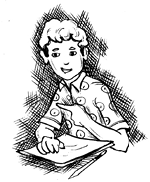
TRY THESE
1. Find selling price (SP) if a profit of 5% is made on
(a) a cycle of ` 700 with ` 50 as overhead charges.
(b) a lawn mower bought at ` 1150 with ` 50 as transportation charges.
(c) a fan bought for ` 560 and expenses of ` 40 made on its repairs.
Example 6: A shopkeeper purchased 200 bulbs for ₹ 10 each. However 5 bulbs were fused and had to be thrown away. The remaining were sold at ₹ 12 each. Find the gain or loss %.
Solution: Cost price of 200 bulbs = ₹ 200 × 10 = ₹ 2000
5 bulbs were fused. Hence, number of bulbs left = 200 – 5 = 195
These were sold at ₹ 12 each.
The SP of 195 bulbs = ₹ 195 × 12 = ₹ 2340
He obviously made a profit (as SP > CP).
Profit = ₹ 2340 – ₹ 2000 = ₹ 340

On ₹ 2000, the profit is ₹ 340. How much profit is made on ₹ 100? Profit =  = 17%.
= 17%.
Example 7: Meenu bought two fans for ₹ 1200 each. She sold one at a loss of 5% and the other at a profit of 10%. Find the selling price of each. Also find out the total profit or loss.
Solution: Overall CP of each fan = ₹ 1200. One is sold at a loss of 5%.
This means if CP is ₹ 100, SP is ₹ 95.
Therefore, when CP is ₹ 1200, then SP = ₹  = ₹ 1140
= ₹ 1140

Also second fan is sold at a profit of 10%.
It means, if CP is ₹ 100, SP is ₹ 110.
Therefore, when CP is ₹ 1200, then SP = ₹  = ₹ 1320
= ₹ 1320
Was there an overall loss or gain?

We need to find the combined CP and SP to say whether there was an overall profit or loss.
Total CP = ₹ 1200 + ₹ 1200 = ₹ 2400
Total SP = ₹ 1140 + ₹ 1320 = ₹ 2460
Since total SP > total CP, a profit of ₹ (2460 – 2400) or ₹ 60 has been made.
TRY THESE
1. A shopkeeper bought two TV sets at ₹ 10,000 each. He sold one at a profit 10% and the other at a loss of 10%. Find whether he made an overall profit or loss.
8.5 Sales Tax/Value Added Tax/Goods and Services Tax
The teacher showed the class a bill in which the following heads were written.
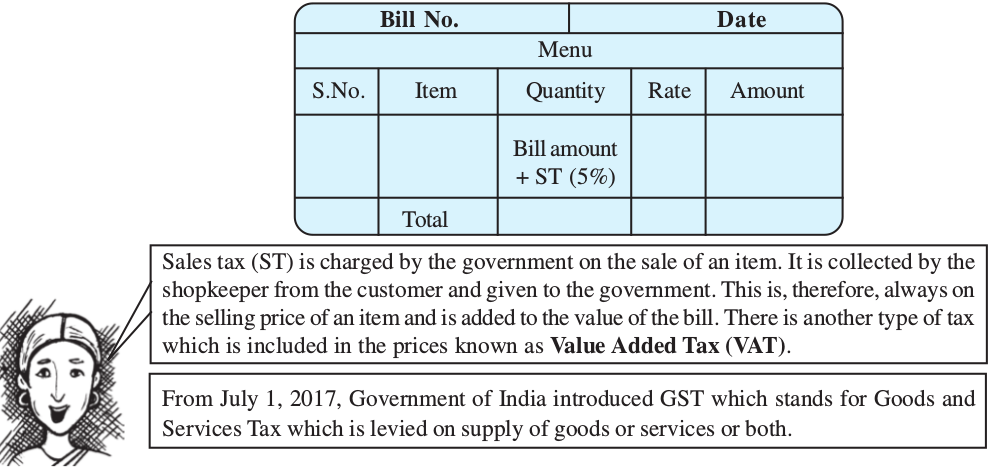

Example 8: (Finding Sales Tax) The cost of a pair of roller skates at a shop was ₹ 450. The sales tax charged was 5%. Find the bill amount.
Solution: On ₹ 100, the tax paid was ₹ 5.
On ₹ 450, the tax paid would be = ₹ 
= ₹ 22.50
Bill amount = Cost of item + Sales tax = ₹ 450 + ₹ 22.50 = ₹ 472.50.

Example 9: (Value Added Tax (VAT)) Waheeda bought an air cooler for ₹ 3300 including a tax of 10%. Find the price of the air cooler before VAT was added.
Solution: The price includes the VAT, i.e., the value added tax. Thus, a 10% VAT means if the price without VAT is ₹ 100 then price including VAT is ₹ 110.
Now, when price including VAT is ₹ 110, original price is ₹ 100.
Hence when price including tax is ₹ 3300, the original price = ₹
Example 10: Salim bought an article for ₹ 784 which included GST of 12% . What is the price of the article before GST was added?
Solution: Let original price of the article be ₹ 100. GST = 12%.
Price after GST is included = ₹ (100+12) = ₹ 112
When the selling price is ₹ 112 then original price = ₹ 100.
When the selling price is ₹ 784, then original price = `  ` 700
` 700

THINK, DISCUSS AND WRITE
1. Two times a number is a 100% increase in the number. If we take half the number what would be the decrease in per cent?
2. By what per cent is ₹ 2,000 less than ₹ 2,400? Is it the same as the per cent by which ₹ 2,400 is more than ₹ 2,000?
Exercise 8.2
1. A man got a 10% increase in his salary. If his new salary is ₹ 1,54,000, find his original salary.

2. On Sunday 845 people went to the Zoo. On Monday only 169 people went. What is the per cent decrease in the people visiting the Zoo on Monday?
3. A shopkeeper buys 80 articles for ₹ 2,400 and sells them for a profit of 16%. Find the selling price of one article.
4. The cost of an article was ₹ 15,500. ₹ 450 were spent on its repairs. If it is sold for a profit of 15%, find the selling price of the article.
5. A VCR and TV were bought for ₹ 8,000 each. The shopkeeper made a loss of 4% on the VCR and a profit of 8% on the TV. Find the gain or loss percent on the whole transaction.
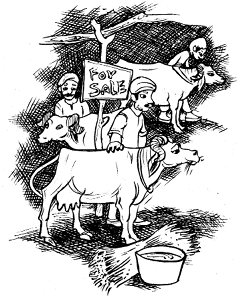
6. During a sale, a shop offered a discount of 10% on the marked prices of all the items. What would a customer have to pay for a pair of jeans marked at ₹ 1450 and two shirts marked at ₹ 850 each?
7. A milkman sold two of his buffaloes for ₹ 20,000 each. On one he made a gain of 5% and on the other a loss of 10%. Find his overall gain or loss. (Hint: Find
CP of each)
8. The price of a TV is ₹ 13,000. The sales tax charged on it is at the rate of 12%. Find the amount that Vinod will have to pay if he buys it.
9. Arun bought a pair of skates at a sale where the discount given was 20%. If the amount he pays is ₹ 1,600, find the marked price.
10. I purchased a hair-dryer for ₹ 5,400 including 8% VAT. Find the price before VAT was added.
11. An article was purchased for ₹ 1239 including GST of 18%. Find the price of the article before GST was added?
8.6 Compound Interest
You might have come across statements like “one year interest for FD (fixed deposit) in the bank @ 9% per annum” or ‘Savings account with interest @ 5% per annum’.

Interest is the extra money paid by institutions like banks or post offices on money deposited (kept) with them. Interest is also paid by people when they borrow money. We already know how to calculate Simple Interest.
Solution: On ` 100, interest charged for 1 year is ` 15.
So, on ` 10,000, interest charged =  = ` 1500
= ` 1500
Interest for 2 years = ₹ 1500 × 2 = ₹ 3000
Amount to be paid at the end of 2 years = Principal + Interest
= ₹ 10000 + ₹ 3000 = ₹ 13000
TRY THESE
Find interest and amount to be paid on ₹ 15000 at 5% per annum after 2 years.

My father has kept some money in the post office for 3 years. Every year the money increases as more than the previous year.
We have some money in the bank. Every year some interest is added to it, which is shown in the passbook. This interest is not the same, each year it increases.

Normally, the interest paid or charged is never simple. The interest is calculated on the amount of the previous year. This is known as interest compounded or Compound Interest (C.I.).
Let us take an example and find the interest year by year. Each year our sum or principal changes.
Calculating Compound Interest
A sum of ` 20,000 is borrowed by Heena for 2 years at an interest of 8% compounded annually. Find the Compound Interest (C.I.) and the amount she has to pay at the end of 2 years.
Aslam asked the teacher whether this means that they should find the interest year by year. The teacher said ‘yes’, and asked him to use the following steps :
1. Find the Simple Interest (S.I.) for one year.
Let the principal for the first year be P1. Here, P1 = ₹ 20,000
SI1 = SI at 8% p.a. for 1st year = ₹  = ₹ 1600
= ₹ 1600
2. Then find the amount which will be paid or received. This becomes principal for the next year.
Amount at the end of 1st year = P1 + SI1 = ₹ 20000 + ₹ 1600
= ₹ 21600 = P2 (Principal for 2nd year)
3. Again find the interest on this sum for another year.
SI2 = SI at 8% p.a.for 2nd year = ₹ 
= ₹ 1728
4. Find the amount which has to be paid or received at the end of second year.
Amount at the end of 2nd year = P2 + SI2
= ₹ 21600 + ₹ 1728
= ₹ 23328
Total interest given = ₹ 1600 + ₹ 1728
= ₹ 3328
Reeta asked whether the amount would be different for simple interest. The teacher told her to find the interest for two years and see for herself.
SI for 2 years = `  = ` 3200
= ` 3200
Reeta said that when compound interest was used Heena would pay ` 128 more.
Let us look at the difference between simple interest and compound interest. We start with ` 100. Try completing the chart.
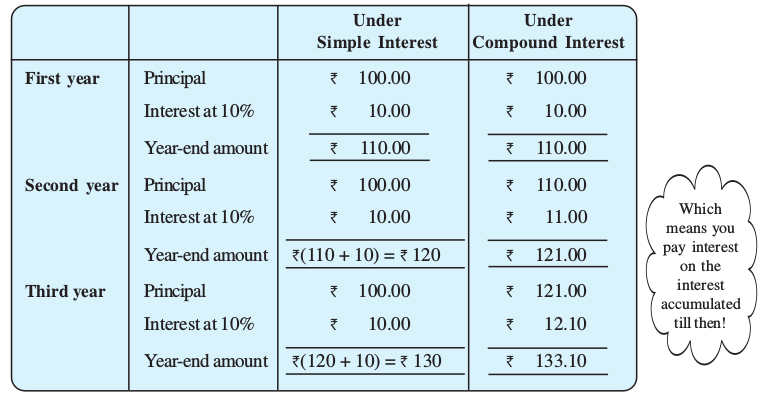
Note that in 3 years,
Interest earned by Simple Interest = ₹ (130 – 100) = ₹ 30, whereas,
Interest earned by Compound Interest = ₹ (133.10 – 100) = ₹ 33.10
Note also that the Principal remains the same under Simple Interest, while it changes year after year under compound interest.
8.7 Deducing a Formula for Compound Interest
Zubeda asked her teacher, ‘Is there an easier way to find compound interest?’ The teacher said ‘There is a shorter way of finding compound interest. Let us try to find it.’
Suppose P1 is the sum on which interest is compounded annually at a rate of R%
per annum.
Let P1 = ` 5000 and R = 5. Then by the steps mentioned above
1. SI1 = ₹  or SI1 = ₹
or SI1 = ₹ 
so, A1 = ` 5000 +  or A1 = P1 + SI1 =
or A1 = P1 + SI1 = 
= ` 5000  = P2 =
= P2 = 
2. SI2 = ` 5000  or SI2 =
or SI2 = 
= `  =
= 
= 
A2 = `  A2 = P2 + SI2
A2 = P2 + SI2
= `  =
=  = `
= `  = P3 =
= P3 = 
= 
Proceeding in this way the amount at the end of n years will be
An = 
Or, we can say A = 
So, Zubeda said, but using this we get only the formula for the amount to be paid at the end of n years, and not the formula for compound interest.
Aruna at once said that we know CI = A – P, so we can easily find the compound interest too.
TRY THESE
1. Find CI on a sum of ` 8000 for 2 years at 5% per annum compounded annually.
Example 11: Find CI on Rs 12600 for 2 years at 10% per annum compounded annually.
Solution: We have, A = P  , where Principal (P) = ` 12600, Rate (R) = 10,
, where Principal (P) = ` 12600, Rate (R) = 10,
Number of years (n) = 2
= ₹  = ₹
= ₹ 
= ₹  = ₹ 15246
= ₹ 15246
CI = A – P = ₹ 15246 – ₹ 12600 = ₹ 2646
8.8 Rate Compounded Annually or Half Yearly (Semi Annually)
Time period and rate when interest not compounded annually
The time period after which the interest is added each time to form a new principal is called the conversion period. When the interest is compounded half yearly, there are two conversion periods in a year each after 6 months. In such situations, the half yearly rate will be half of the annual rate. What will happen if interest is compounded quarterly? In this case, there are 4 conversion periods in a year and the quarterly rate will be one-fourth of the annual rate.
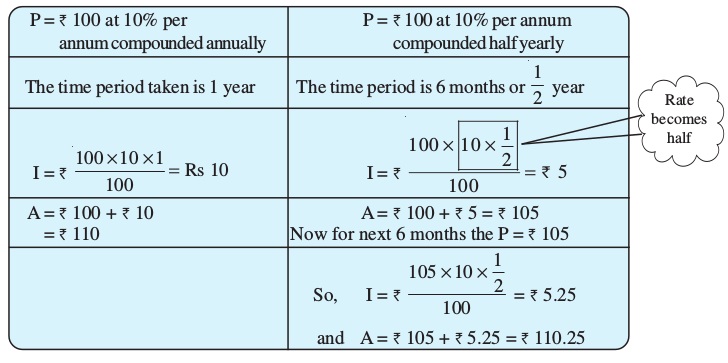

Do you see that, if interest is compounded half yearly, we compute the interest two times. So time period becomes twice and rate is taken half.
TRY THESE
Find the time period and rate for each .
1. A sum taken for  years at 8% per annum is compounded half yearly.
years at 8% per annum is compounded half yearly.
2. A sum taken for 2 years at 4% per annum compounded half yearly.
THINK, DISCUSS AND WRITE
A sum is taken for one year at 16% p.a. If interest is compounded after every three months, how many times will interest be charged in one year?
Example 12: What amount is to be repaid on a loan of ` 12000 for 1 years at 10% per annum compounded half yearly.
years at 10% per annum compounded half yearly.
Solution:
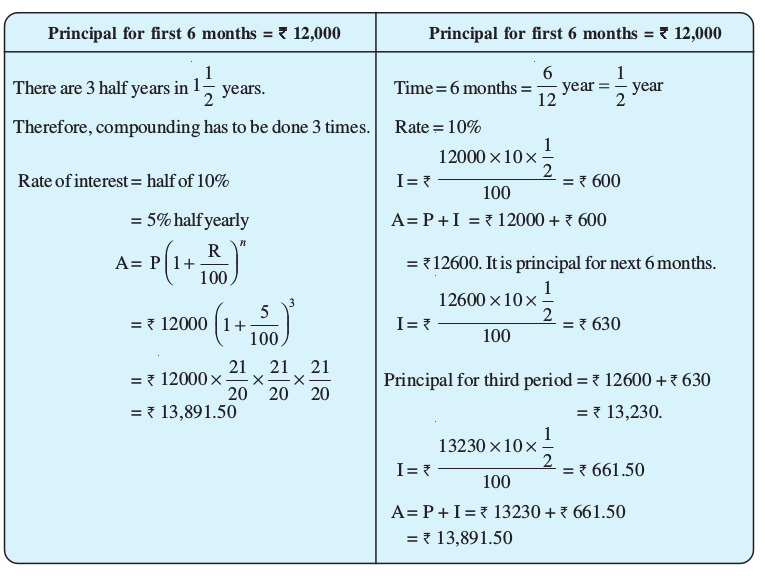
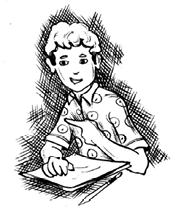
TRY THESE
Find the amount to be paid
1. At the end of 2 years on ₹ 2,400 at 5% per annum compounded annually.
2. At the end of 1 year on ₹ 1,800 at 8% per annum compounded quarterly.
Example 13: Find CI paid when a sum of ` 10,000 is invested for 1 year and
3 months at 8 % per annum compounded annually.
% per annum compounded annually.
Solution: Mayuri first converted the time in years.
1 year 3 months =  year =
year =  years
years
Mayuri tried putting the values in the known formula and came up with:
A = ₹ 10000 
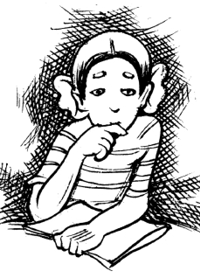
Now she was stuck. She asked her teacher how would she find a power which is fractional?
The teacher then gave her a hint:
Find the amount for the whole part, i.e., 1 year in this case. Then use this as principal to get simple interest for  year more. Thus,
year more. Thus,
A = ₹ 10000 
= ₹ 10000 ×  = ₹ 10,850
= ₹ 10,850
Now this would act as principal for the next  year. We find the SI on ₹ 10,850
year. We find the SI on ₹ 10,850
for  year.
year.
SI = ₹ 
= ₹  = ₹ 230.56
= ₹ 230.56
Interest for first year = ₹ 10850 – ₹ 10000 = ₹ 850
And, interest for the next  year = ₹ 230.56
year = ₹ 230.56
Therefore, total compound Interest = 850 + 230.56 = ₹ 1080.56.
8.9 Applications of Compound Interest Formula
There are some situations where we could use the formula for calculation of amount in CI. Here are a few.
(i) Increase (or decrease) in population.
(ii) The growth of a bacteria if the rate of growth is known.
(iii) The value of an item, if its price increases or decreases in the intermediate years.
Example 14: The population of a city was 20,000 in the year 1997. It increased at the rate of 5% p.a. Find the population at the end of the year 2000.
Solution: There is 5% increase in population every year, so every new year has new population. Thus, we can say it is increasing in compounded form.
Population in the beginning of 1998 = 20000 (we treat this as the principal for the 1st year)

Increase at 5% = 
Population in 1999 = 20000 + 1000 = 21000
Treat as the Principal for the 2nd year.
Increase at 5% = 
Population in 2000 = 21000 + 1050
= 22050
Treat as the Principal for the 3rd year.
Increase at 5% = 
= 1102.5
At the end of 2000 the population = 22050 + 1102.5 = 23152.5
or, Population at the end of 2000 = 20000 
= 
= 23152.5
So, the estimated population = 23153.

Aruna asked what is to be done if there is a decrease. The teacher then considered the following example.
Example 15: A TV was bought at a price of ₹ 21,000. After one year the value of the TV was depreciated by 5% (Depreciation means reduction of value due to use and age of the item). Find the value of the TV after one year.
Solution:
Principal = ₹ 21,000
Reduction = 5% of ₹ 21000 per year
= ₹  = ₹ 1050
= ₹ 1050
value at the end of 1 year = ₹ 21000 – ₹ 1050 = ₹ 19,950
Alternately, We may directly get this as follows:
value at the end of 1 year = ₹ 21000 
= ₹ 21000 ×  = ₹ 19,950
= ₹ 19,950

TRY THESE
1. A machinery worth ₹ 10,500 depreciated by 5%. Find its value after one year.
2. Find the population of a city after 2 years, which is at present 12 lakh, if the rate of increase is 4%.
Exercise 8.3
1. Calculate the amount and compound interest on
(a) ₹ 10,800 for 3 years at 12 % per annum compounded annually.
% per annum compounded annually.
(b) ₹ 18,000 for 2 years at 10% per annum compounded annually.
years at 10% per annum compounded annually.
(c) ₹ 62,500 for 1 years at 8% per annum compounded half yearly.
years at 8% per annum compounded half yearly.
(d) ₹ 8,000 for 1 year at 9% per annum compounded half yearly.
(You could use the year by year calculation using SI formula to verify).
(e) ₹ 10,000 for 1 year at 8% per annum compounded half yearly.
2. Kamala borrowed ₹ 26,400 from a Bank to buy a scooter at a rate of 15% p.a. compounded yearly. What amount will she pay at the end of 2 years and 4 months to clear the loan?
(Hint: Find A for 2 years with interest is compounded yearly and then find SI on the 2nd year amount for  years).
years).
3. Fabina borrows ₹ 12,500 at 12% per annum for 3 years at simple interest and Radha borrows the same amount for the same time period at 10% per annum, compounded annually. Who pays more interest and by how much?
4. I borrowed ₹ 12,000 from Jamshed at 6% per annum simple interest for 2 years. Had I borrowed this sum at 6% per annum compound interest, what extra amount would I have to pay?
5. Vasudevan invested ₹ 60,000 at an interest rate of 12% per annum compounded half yearly. What amount would he get
(i) after 6 months?
(ii) after 1 year?
6. Arif took a loan of ₹ 80,000 from a bank. If the rate of interest is 10% per annum, find the difference in amounts he would be paying after  years if the interest is
years if the interest is
(i) compounded annually.
(ii) compounded half yearly.
7. Maria invested ₹ 8,000 in a business. She would be paid interest at 5% per annum compounded annually. Find
(i) The amount credited against her name at the end of the second year.
(ii) The interest for the 3rd year.
8. Find the amount and the compound interest on ₹ 10,000 for  years at 10% per annum, compounded half yearly. Would this interest be more than the interest he would get if it was compounded annually?
years at 10% per annum, compounded half yearly. Would this interest be more than the interest he would get if it was compounded annually?
9. Find the amount which Ram will get on ₹ 4096, if he gave it for 18 months at  per annum, interest being compounded half yearly.
per annum, interest being compounded half yearly.
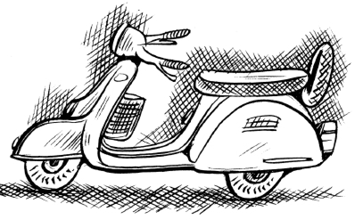
10. The population of a place increased to 54,000 in 2003 at a rate of 5% per annum
(i) find the population in 2001.
(ii) what would be its population in 2005?
11. In a Laboratory, the count of bacteria in a certain experiment was increasing at the rate of 2.5% per hour. Find the bacteria at the end of 2 hours if the count was initially 5, 06,000.
12. A scooter was bought at ₹ 42,000. Its value depreciated at the rate of 8% per annum. Find its value after one year.
WHAT HAVE WE DISCUSSED?
1. Discount is a reduction given on marked price.
Discount = Marked Price – Sale Price.
2. Discount can be calculated when discount percentage is given.
Discount = Discount % of Marked Price
3. Additional expenses made after buying an article are included in the cost price and are known as overhead expenses.
CP = Buying price + Overhead expenses
4. Sales tax is charged on the sale of an item by the government and is added to the Bill Amount.
Sales tax = Tax% of Bill Amount
5. GST stands for Goods and Services Tax and is levied on supply of goods or services or both.
6. Compound interest is the interest calculated on the previous year’s amount (A = P + I)
7. (i) Amount when interest is compounded annually
=  ; P is principal, R is rate of interest, n is time period
; P is principal, R is rate of interest, n is time period
(ii) Amount when interest is compounded half yearly
= 
